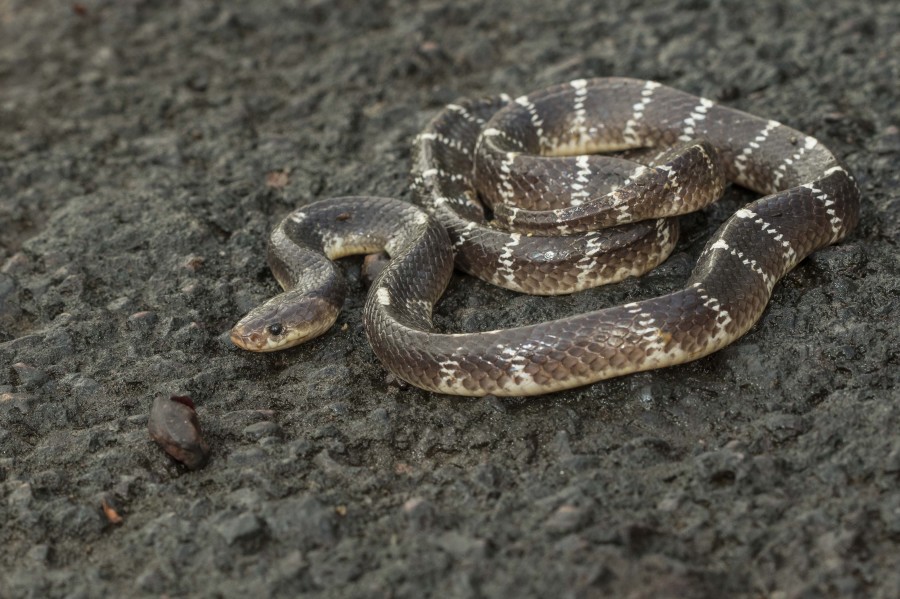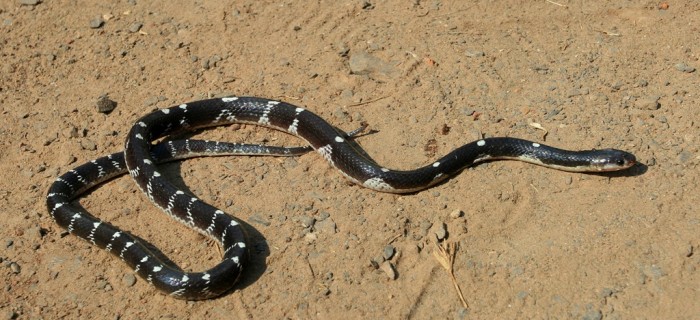Click on the pic to load it in high resolution
Of the ‘Big Four’ dangerous snakes found in India, the Common Krait is the most venomous. Its venom – a powerful neurotoxin – is supposed to be fifteen times more virulent than that of the Common Cobra, making it probably the most venomous snake in Asia and earning it a rank among the deadliest snakes of our planet!
Paradoxically, this deadly snake is also the most placid and gentle of the ‘Big Four’. I’ve seen some snake handlers lift wild Kraits by slipping their bare fingers under the snake’s mid-body. Even the Irulas with whom I trained, would handle this snake exercising half the caution and twice the gentleness they normally kept for a Cobra or a Russell’s viper.
The fact remains, of course, that the Krait is most active at night – definitely a far better time to judge this snake if you are awarding it points for manners!
On the other hand, all of the handlings I’ve seen of this snake took place in the day time when this snake appears especially shy and prefers hiding its head under its coils. Just look at the photographs I’ve shot of this snake in daylight.
However, all my own handlings of this snake – while attending snake calls – took place during the night: a time far more unsettling for handling this nocturnal reptile. Kraits come alive at night and move with unnerving speed in their attempts to elude capture. Even so they rarely hiss or strike and are far less aggressive than Russell’s vipers and Saw-scaled vipers.
This habit of the Krait – moving around only at night – may be the reason I receive so few calls for this species. (A jet black snake moving in pitch darkness is not the easiest thing to spot!) I myself have only caught six or seven of these snakes in the twelve odd years I’ve been attending snake calls.
I rescued the one shown in the photograph less than two months ago. The snake turned up under a cot in the bedroom of a person’s house. The occupants, an elderly couple, spent a sleepless night keeping a watch over the snake as it fritted in between coconuts and old metal trunks stashed under the bed. First thing next morning they sent someone to fetch me.
That particular Krait was one of the friskiest I’d ever seen. Even so I managed to bag it safely. Two days later when I made a routine check on the bag, I felt the snake lying stiff inside. I assumed it was dead.
Just to make sure though, I prodded the snake inside the bag with my snake stick a couple of times. The snake remained as hard and immobile as a piece of wood. I opened the bag and edged the snake out.
It was fortunate that I had remained a safe distance from the bag for the apparently dead snake suddenly shot its head in the air with lightning speed. It was the first time I was actually seeing a snake playing dead!
My heart picked up beats like a racing engine as I contemplated what would have happened had I been any less careful getting the snake out of that bag. The only penalty I received for my mistake this time was that I had to bag the frisky Krait all over again!
Interesting facts about the Common Krait:
- Feeds mostly on other snakes, but occasionally takes mice, lizards and frogs.
- Is oviparous (egg-laying) and lays 8-12 eggs per clutch.
- Is confused with the Common Wolf Snake as both are dark coloured with white lines across their bodies. The difference between the two is that the Wolf Snake has white bands markedly more prominent in the head region which disappear towards the tail end. The Krait, on the other hand, has thin white lines mostly located in the posterior half of the snake’s body, but disappearing toward the head.


